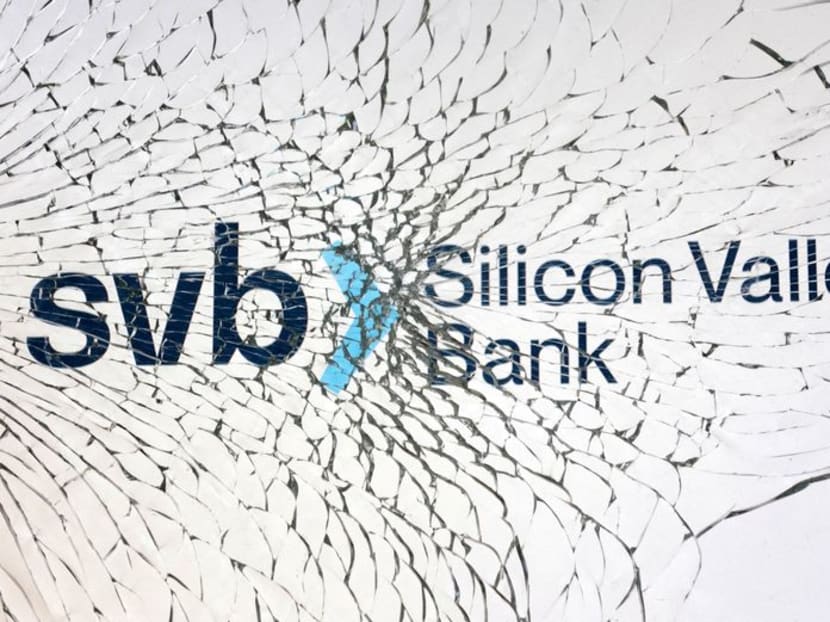Explainer: Why did Silicon Valley Bank collapse, will S'pore's banks and startup scene be affected?
SINGAPORE — The plight of Silicon Valley Bank (SVB) has sent shock waves through financial markets after the go-to bank for United States tech startups faced a sudden bank run and then became the largest US bank to fail since 2008.

The Silicon Valley Bank logo is seen through broken glass in this illustration taken March 10, 2023.
- The collapse of Silicon Valley Bank rocked the market after the go-to bank for tech startups in the US faced a bank run and quickly became insolvent
- The failure of a second American bank, New York-based Signature Bank, just days later added to global jitters
- However, the US authorities acted quickly to calm investors, by guaranteeing that no depositor would be out of pocket, among other measures
- Analysts said that no material impact is expected on technology companies or funds in Southeast Asia for now
- They added that there has not been any impact on Singapore banks because there are several fundamental differences that set lenders here apart from Silicon Valley Bank
SINGAPORE — The plight of Silicon Valley Bank (SVB) has sent shock waves through financial markets after the go-to bank for United States tech startups faced a sudden bank run and then became the largest US bank to fail since 2008.
Adding to global jitters, a second financial institution in the US, New York-based Signature Bank, which had held up to US$110 billion (S$148 billion) in assets, closed its doors just days later on Sunday (March 12).
The US authorities moved quickly to calm the situation by guaranteeing that no depositor would be left out of pocket at either bank, among other steps.
The two failures in rapid succession evoked for some the start of the global financial crisis in September 2008 when investment bank Lehman Brothers failed and other financial institutions teetered on the brink of collapse.
On Monday, HSBC announced that it is acquiring SVB’s United Kingdom subsidiary for £1 (S$1.63), protecting the deposits of SVB UK's clients, after a weekend of frantic negotiations by UK officials.
TODAY takes a look at the factors that brought down SVB and the implications for financial institutions outside the US, including in Singapore.
WHAT CAUSED SVB'S FAILURE?
SVB specialised in financing startups and had become the 16th largest US bank by assets. At the end of 2022, it had US$209 billion in assets and about US$175.4 billion in deposits.
Its demise represents not only the largest bank failure since Washington Mutual in 2008, but also the second-largest failure for a retail bank in the US.
One key factor leading to SVB's failure has been the aggressive drive by the US Federal Reserve, along with other central banks around the world, to increase interest rates to combat inflation.
As borrowing money became more expensive, the flow of cash from sources such as venture capitalists began to dry up, causing many of SVB's startup clients to withdraw funds from their accounts to cover their cash-flow requirements.
To meet these withdrawals, SVB began to sell some of its investments in bonds, including long-term government bonds known as treasuries. Banks typically don't keep all deposits as cash but rather invest much of them to achieve a better return.
At a time of higher interest rates, existing bond prices tend to fall as newer issues try to compete with higher returns so SVB sold some of its bond portfolio at a loss. Then, in order to cover that loss, SVB sold some of its own share stock.
All this made bank depositors very nervous and more began pulling out their funds. Unlike a typical retail bank, most of the deposits were large sums, so SVB quickly became insolvent in a classic case of a bank run.
California banking regulators shut down SVB on Friday after depositors pulled out as much as US$42 billion (S$56.4 billion) on a single day.
On Sunday night, US regulators announced that they will protect depositors’ funds by setting up a new financial backstop, following fears that people would flee other small banks.
Some commentators have raised questions about whether the US authorities should have taken earlier action given SVB's exposure to the bond market in a rapidly rising interest rate environment.
WHY WOULD HSBC BUY SVB’S UK ARM?
Economist Song Seng Wun from CIMB Private Banking said that HSBC probably acquired the unit to increase its presence in the country.
“Given how SVB was among the top 20 banks in the US, HSBC obviously sees the potential. There are also perhaps assets in SVB that are worth salvaging.”
Phillip Securities research analyst Glenn Thum said the acquisition will give HSBC access to SVB’s customer base, which means HSBC will also be acquiring a high number of tech companies.
“If not for this, how else can a bank like HSBC acquire such a niche customer base? Plus, they’re getting it at a discount,” he said.
WHAT IS IMPACT OF COLLAPSE BEYOND THE US, INCLUDING IN SINGAPORE?
Fears of contagion may have reached countries where SVB had branches, such as the UK, Australia and Canada, but there has not been any fallout in this part of the world, said analysts.
The Monetary Authority of Singapore (MAS) said on Monday that exposure here to the two US banks was "insignificant" and that the banking system here remained sound and resilient.
“Regulators worldwide and multilateral financial institutions also have a wide range of intervention tools in their arsenal to prevent systemic risk from materialising, which is a beneficial legacy of the 2008/09 global financial crisis.Mr Taimur Baig, chief economist of DBS bank”
Mr Taimur Baig, chief economist of DBS bank, said that both the US and the global financial systems have sufficient buffers in place to deal with any losses or contagion stemming from SVB’s troubles.
“Regulators worldwide and multilateral financial institutions also have a wide range of intervention tools in their arsenal to prevent systemic risk from materialising, which is a beneficial legacy of the 2008/09 global financial crisis,” he added.
Mr Song from CIMB said that analysts are still watching out for the contagion effects of SVB’s lightening collapse, but the moves by US regulators to contain panic and shore up market confidence to avoid a wider bank run have helped stabilise the situation.
He noted that US equity futures went up by more than 1 per cent on Monday after regulators guaranteed all SVB customers that they would have access to their deposits, which means the contagion risks have been mitigated by the US policy responses.
Mr Baig said that the collapse of SVB has ramifications beyond the stability of the banking sector.
“The sharp increase in global interest rates over the past year, if history is any guide, ought to be a source of stress in some pockets of the global economy and markets. And yet, last year’s Fed lift-off was absorbed surprisingly well by global markets," he added.
Mr Peter Cheng, Maybank’s head of internet and technology, media, and telecom investment banking and advisory, said that no material impact is expected in the near term on technology companies or funds in Southeast Asia, given the limited direct and indirect exposure to SVB.
“While short-term market sentiment may be affected, we expect the pace of technology-related fundraising, mergers and acquisitions, and IPOs (initial public offerings) to remain resilient.
“Southeast Asia technology companies may even come out of this more robust as investors seek to strengthen their investment management processes to mitigate any future risks of this reoccurring to their portfolio companies.”
An IPO is when a firm that is listing on the stock exchange sells its shares to public investors.
COULD MARKET FORCES THAT TOOK DOWN SVB DO THE SAME TO SINGAPORE BANKS?
Analysts said that there has not been any impact on Singapore banks, arguing that there are several fundamental differences that set lenders here significantly apart from SVB.
Mr Thilan Wickremasinghe, Maybank Securities Singapore's head of research, said in Maybank’s Asean Speaks podcast on Monday morning that the systemic risk is relatively low, especially for banks here.
“A large part of SVB’s client base is startups... Singapore banks’ customer bases tend to be mostly large corporates, as well as more premium clientele.”
Agreeing, Mr Thum from Phillip Securities noted that bonds made up 57 per cent of SVB’s total assets. In comparison, they make up 12 to 19 per cent of the total assets in banks here.
“While Singapore banks also definitely face bond losses, the majority of the assets are in loans so Singapore banks are able to pass on the higher interest rates to customers,” he said.
WHAT SINGAPORE TECH INSIDERS SAY ABOUT THE COLLAPSE
Tech startup insiders here who spoke to TODAY said that they were not affected by the collapse of SVB because they mostly borrowed from Singapore or regional banks. They also did not expect its failure to have repercussions on the tech startup scene here and the region.
Mr Jan Gasparic, the co-founder and chief executive officer of Fairmart, said that unlike SVB, banks in Southeast Asia did not typically have a high concentration of deposits from a single sector.
While bank runs could happen to any bank, it is an unusual occurrence and “a long-tail risk”.
Mr Tamir Shklaz, the co-founder of Strive Math, an online coding school for children, said that had his company been in the midst of fundraising, his company could have found it more challenging to raise funds because SVB’s collapse would lead to investors becoming more conservative about where to put their investments.
This would be because SVB’s collapse would have affected investors’ general confidence in the startup ecosystem, since startup investment could be seen as a more risky form of investment.
Existing investors would also want to prioritise the well-being of their existing portfolio of startups rather than invest in new ones, he said.
However, Mr Shklaz said that SVB’s collapse could lead to investors seeing Singapore as a safer place to set up given the stronger banking eco-system here.













